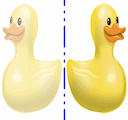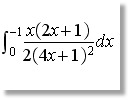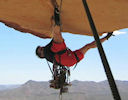IntMath Newsletter: brain games, music, impossible integrals
By Murray Bourne, 10 Sep 2010
10 Sep 2010
In this Newsletter:
1. Resource: Lumosity brain games
2. Music and transformation geometry
3. What does Japan's history tell us about the DJIA's future?
4. Impossible integral question
5. Friday math movie: Math of rock climbing
6. Final thought: water
1. Resource: Lumosity brain games
I came across Lumosity recently. It claims to "improve memory and attention with scientific brain games". There are many games in there (the trial is free, but you need to pay for the full program) and most of them will help improve your math skills.
I played some of the games (speed, attention and memory) and found it quite useful. Other areas are flexibility and problem solving.
So give it a go - improve your math skills while playing games! (You need to set up a free account first).
[Disclaimer: I have no connection with Lumosity.]
2. Music and transformation geometry
Suitable for: Everyone.
 |
Composers use many ideas from geometry when they write music. In this article, you can hear some music I wrote. |
3. What does Japan's history tell us about the DJIA's future?
Suitable for: This article describes an application of exponential functions, and describes a scenario that may affect the finances of millions of people.
 |
Will the DJIA follow the Nikkei down into oblivion? Japan's story may give us a clue. |
4. Impossible integral question
Suitable for: This is for those of yoou who are studying integration, a calculus topic.
 |
Scarlett has trouble solving an integration problem. It's no wonder, since the problem is impossible! |
5. Friday math movie: Math of rock climbing
Suitable for: Everyone.
 |
Here is a real life application of math - life and death, in fact. Watch the video: |
6. Final thought: water
Quite a few students write to me asking for advice on project topics, or even which degree they should study.
For example, Aditya wrote from India:
I wish to do some research in Mathematics (any field) where I can learn more and if possible find new things.
This was my reply:
One of the biggest problems in the 21st century is going to be water. I would encourage you to work on any project that helps to improve the efficient and sustainable use of water. Much water is wasted through industrial and agricultural inefficiencies. The mathematics behind this can be very interesting. You would learn about differential equations, modeling, fluid mechanics and so on.
Find a problem on this topic (if it is in your local area, it's even better) and work on it. You have the potential to make many people a lot happier.
As the world becomes even more over-populated and its resources continue to be wasted and polluted, there will be many job opportunities in water management. The 21st century will challenge the brightest minds - I hope you are one of them.
Until next time, enjoy whatever you learn.
See the 8 Comments below.
11 Sep 2010 at 7:52 pm [Comment permalink]
i am happy because i got read this aticle.It is more informative .Thank you for this article.
15 Sep 2010 at 9:45 am [Comment permalink]
Hi!
Thanks for tips on how to choose research topics.I have applied for a Masters programme next year. Last time after reading your newsletter, I was touched when I observed how my students misuse the equal sign, apparently I was left wondering how can make a research on this topic. I feel I can make a change in this regard. Water is quite intersting too, I would be very happy if you could shade more light.Does one needs a specific Chemistry or physics background to do such a reserch?
Desmond.
16 Sep 2010 at 10:40 am [Comment permalink]
Hi Desmond. For water research, a physics background will definitely help, and chemistry certainly won't hurt!
17 Sep 2010 at 2:20 am [Comment permalink]
Thanks for lumosity. I have just started a course in Discrete Mathematics and these games couldn't have come at a better time. Plus it is fun.
23 Sep 2010 at 9:35 pm [Comment permalink]
In astronomy, the Earth's orbit is the motion of the Earth around the Sun, at an average distance of about 150 million kilometers, every 365.242199 mean solar days (1 sidereal year). This motion gives an apparent movement of the Sun with respect to the stars at a rate of about one degree per day (or a Sun or Moon diameter every 12 hours) eastward, as
seen from Earth.
I know that the term of "average distance" are varies between 147 million kilometers (perihelion) to 149 million kilometers (aphelion) according to your example. I would like to find the formula which express the relationship
between earth's movement at every one degree per day with the distance from earth to sun and the arc length's of earth movement at such angle
Since I learn from your web that the earth's orbit around the sun is like an ellipse shape; with semi major axis 152 million kilometers, It is difficult for me to count how long the distance from earth to sun at every rate of change about one degree/day (with the sun as the center of ellipse)
Thank for your response
24 Sep 2010 at 6:26 am [Comment permalink]
Hi Amri. This page could be what you are looking for: Elliptical orbit
6 Nov 2010 at 6:24 am [Comment permalink]
I am enjoying your news letter and using it in my volunteering math classes.
I like your comment regarding water issue. I am an civil engineer, majored in water resouce engineering. I have designed an arch dam to build small check dams used by farmers in India to save their crops during dry spells. My design is using concrete blocks made from 100% waste material, fly ash, and cost just 10% of the government designed check dams.
I am looking for people to take this idea to solve irrigation water problems, particularly rain-fed farming areas.
If anybody interested, I can provide more details.
Regards,
Chiman Delwadia
6 Nov 2010 at 8:45 am [Comment permalink]
Thanks for sharing the interesting story, Chiman.
So how about it, readers - anyone interested to take this further?